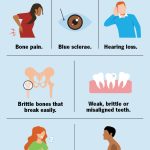When you think of brittle, what comes to mind? Perhaps something fragile and prone to breaking, like a piece of glass or a delicate vase. But when it comes to human bones, brittleness can be a life-altering condition.
Brittle Bone Disease Type 1: More Than Just a Broken Bone
Brittle bone disease type 1, also known as osteogenesis imperfecta (OI), is a genetic disorder that affects the production of collagen, a vital protein that gives structure to our bones. This rare condition causes bones to be extremely fragile and prone to breaking, often without warning.
A Life of Fragility
Imagine living with the constant fear of snapping a bone simply by doing everyday activities like bending or coughing. For people with OI, this is a harsh reality. The condition can cause bones to break spontaneously, leading to chronic pain, limited mobility, and a significantly reduced quality of life.
In this blog post, we’ll delve into the world of brittle bone disease type 1, exploring its causes, symptoms, and effects on daily life. We’ll also discuss treatment options and offer hope for those affected by this condition.
Brittle bone disease type 1, or osteogenesis imperfecta (OI), is a complex condition that affects the way our bones grow and develop. As we explore this topic further, it’s essential to understand the underlying causes of OI.
The Genetics of Brittle Bone Disease Type 1
Brittle bone disease type 1 is caused by genetic mutations in the COL1A1 or COL1A2 genes, which are responsible for producing collagen. Collagen plays a crucial role in giving structure to our bones, tendons, and ligaments. When the production of collagen is impaired, it can lead to brittle bones that are prone to breaking.
Most cases of OI are inherited in an autosomal dominant pattern, meaning that a single copy of the mutated gene is enough to cause the condition. However, some cases may occur spontaneously due to new mutations during egg or sperm formation.
Symptoms and Diagnosis
The symptoms of brittle bone disease type 1 can vary in severity, but common signs include:
- Bone fractures at an early age, often without any apparent trauma or injury
- Bones that are abnormally shaped or have a blue tint (a sign of underlying collagen defects)
- Short stature due to frequent bone fractures and limited mobility
- Painful joints and muscles due to repeated breaks and healing processes
- Weakened immune system, increasing the risk of infections
Diagnosing OI can be challenging, especially in mild cases. A combination of physical examination, medical history, and laboratory tests (such as X-rays or genetic testing) are often necessary to confirm a diagnosis.
Treatment and Management
While there is no cure for brittle bone disease type 1, various treatments can help manage symptoms and improve quality of life. Some common approaches include:
- Bone density medications, such as bisphosphonates, to reduce the risk of fractures
- Pain management strategies, including physical therapy and medication
- Surgical interventions to stabilize or correct bone deformities
- Assistive devices, such as canes or walkers, to aid mobility
For more information on brittle bone disease type 1 and its treatment options, visit the National Osteogenesis Imperfecta Foundation’s (NOF) website (oif.org). The NOF provides a wealth of resources, including support groups and educational materials, for individuals affected by OI.
In our next installment, we’ll explore the effects of brittle bone disease type 1 on daily life, as well as strategies for coping with this condition. Stay tuned for more insights into the world of OI.
Expert Consultation for Brittle Bone Disease Type 1
Get expert advice on managing and coping with brittle bone disease type 1. Our medical experts are here to help.
Schedule a consultationIn our previous installment, we explored the ins and outs of brittle bone disease type 1, also known as osteogenesis imperfecta (OI). We delved into the genetic disorder that causes bones to be extremely fragile and prone to breaking, often without warning.
A Summary of Key Points
We covered:
- The rare genetic disorder OI, which affects collagen production in bones.
- The devastating effects on daily life, including chronic pain, limited mobility, and reduced quality of life.
- The constant fear of snapping a bone due to everyday activities like bending or coughing.
Final Insights
Despite the challenges posed by OI, there is hope. Advances in medical technology and treatment options have improved the lives of those affected by this condition. From medications to manage pain and prevent further breaks, to physical therapy to maintain mobility and independence, there are ways to live with OI.
Perhaps most importantly, education and awareness can go a long way in reducing stigma and promoting understanding. By sharing the stories and experiences of those living with OI, we can work together to create a more supportive and inclusive community.
A Call to Action
As we conclude our exploration of brittle bone disease type 1, we urge you to join us in spreading awareness and support for those affected by this condition. Whether it’s through volunteering at a local organization, sharing information on social media, or simply being an ally to someone living with OI, every effort counts.
Let’s work together to create a world where everyone can live without the fear of snapping a bone. A world where quality of life is valued and respected. A world where brittle bone disease type 1 is just one of many challenges we face, but not insurmountable ones.
The Best Dog for a Single Female Living in an Apartment: Looking for the paw-fect furry companion? Find out which dog breeds are perfect for single females living in apartments, considering factors like energy level, size, and grooming needs. Get ready to fall in love with your new best friend!
Answer the Questions Below about the Highlighted Atom in this Lewis Structure CCCNHHHH: Get ready to geek out and challenge your chemistry skills! Dive into a fascinating atom-based puzzle and test your knowledge of chemical structures. Can you solve it?


